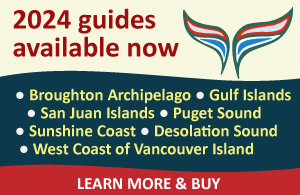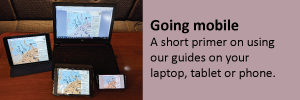Spoils of Beaver Harbour

The intended overnight can quickly turn into a two- or three-night stay. It is a good anchorage with excellent cover from Vancouver Island or from the small islands in the harbour. The views out to Queen Charlotte Strait are lovely and there is much for active boaters to do.

In August 1792, the Spanish explorers Valdez and Galiano anchored their ships off Thomas Point and spent a miserable night in brutal northwesterlies. Not the best choice of anchorages at a time when there were few cruising guides.
Beaver Harbour was named in 1837 by officers of the Hudson’s Bay Company, not for the animal but after HBC’s paddle steamer Beaver, the first steam vessel on the northwest coast. The company had established fur-trading outposts ashore, but built Fort Rupert, with canons and five-metre walls, to watch over their coal deposits in the area.

The most secure anchorages in the harbour depend on the forecast wind direction, so vessels can choose to anchor tucked in the lee of Vancouver Island or off Peel Island or the Cattle Islands.
The islands protecting the harbour are fun to explore, and the super-wide beach along the southern shore of the bay is enchanting to walk at low tide. As well, there are challenging trails and the historic village of Fort Rupert.

East of Cormorant Rock, tiny Shell Island is worth a visit. It is covered by pebbly sand and shells crushed by time that in a certain light looks like snow. It is a wonderful spot for a picnic or a swim. Note, it is First Nations land and off limits to visitors during the Covid-19 pandemic.
The campsite at the west end of Peel Island is also a pleasant place to pull a dinghy or kayak ashore and build a fire to cook dinner. It provides shelter from the wind.

Fit boaters will want to tackle Tex Lyon Trail which runs 13km from its trailhead to Dillon Point. It is a challenging adventure, informally maintained and some sections are overgrown from light use. Budget a full day. While boaters can bring a dinghy ashore at Basket Eater’s Cove, cutting the trail roughly in half, trekkers should still bring good walking shoes, food and water.
If wanting to walk Storey’s Beach on the southern shore of the bay or visit the village of Fort Rupert, the easiest shore access by dinghy or kayak, depending on the tide, is north of the Tex Lyon trailhead, where the drying beach is narrower and there are steeper landings where you can paddle ashore and secure your dinghy in a spot safe from rising water.

Fort Rupert is a Kwakwaka’wakw village of the Kwakiutl First Nation, its people long known for carving totem poles and other traditional crafts. Today there are totem poles along the shore near the longhouse and carving is often observed in the village. There is a general store stocked with essential groceries, snacks and gifts,
There is apparently no record of Indigenous settlements here before Europeans arrived, but gleaming white shell beaches along the harbour shores betray thousands of years of activity. Petroglyphs are reported to exist on the sandstone formations below the former fort site, but are difficult to find; luck or local knowledge required.
The spoils of Beaver Harbour are open to the curious. For many, this afterthought has become a pleasant memory.
Stay safe.
(Beaver Harbour is covered in Salish Sea Pilot’s Cruising Guide to the Broughton Archipelago.)



















